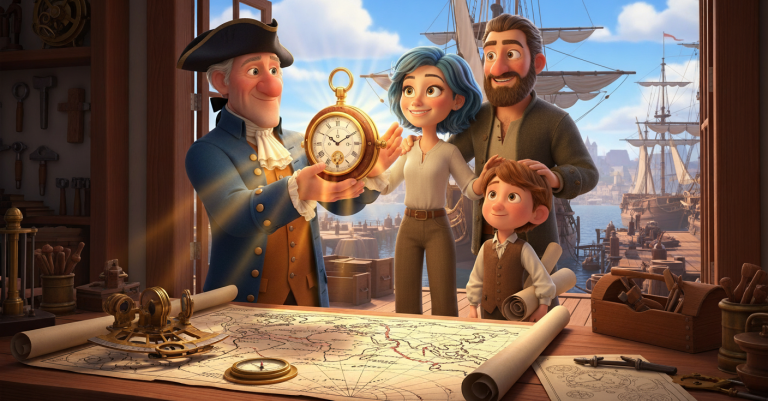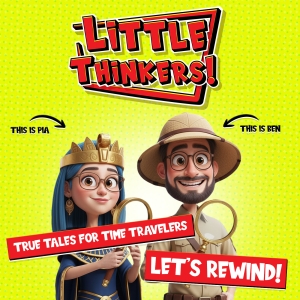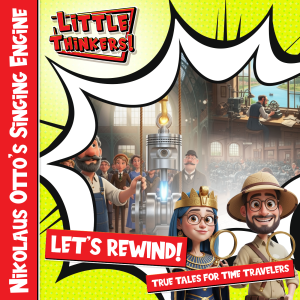The Clockmaker Who Conquered the Sea: John Harrison’s Amazing Adventure
Imagine Being Lost at Sea Forever
Imagine you’re on a huge wooden ship, surrounded by endless ocean in every direction. There’s no GPS, no compass pointing to safety, and no way to know where you are on Earth. The waves are taller than houses, and thick fog hides everything. Your captain looks worried because he doesn’t know if you’re sailing toward home or toward dangerous rocks that could sink the ship!
This terrifying situation happened to sailors every single day about 300 years ago. Ships would disappear forever, and families would never know what happened to their loved ones. But one quiet man with steady hands and an amazing idea changed everything. His name was John Harrison, and he was about to solve one of the world’s greatest puzzles!
The Boy Who Listened to Time
Our story begins in Yorkshire, England, around 1700. Young John Harrison lay in his bed during a cold winter night, listening to something very special. A borrowed watch lay beside him, making its gentle tick, tick, tick. John had been sick with fever, but the steady sound of the watch helped calm him down.
While other children might have been bored by a watch’s sound, John was fascinated! He listened carefully to every tick. He watched the tiny hands move like miniature travelers across the watch face. His father was a carpenter who worked with wood all day, and their small house smelled like wood shavings and sawdust.
Did You Know?
John Harrison grew up in a time when most people told time by looking at the sun or listening for church bells. Having a personal watch was as rare and expensive as owning a sports car today!
That winter night, something magical happened in John’s mind. He realized that time wasn’t just something you felt passing by – it was something you could capture, measure, and control. This idea would grow in his head for many years, like a seed waiting to become a mighty tree.
The Wooden Clock Genius
As John grew up, he learned his father’s carpentry skills. But instead of just making tables and chairs, John had a brilliant idea. Around 1715, when he was about 22 years old, he built his first clocks entirely out of wood! But not just any wood – he used a special type called lignum vitae.
Lignum vitae was like nature’s perfect clock material. It had natural oils inside that kept the wooden gears sliding smoothly, just like having built-in lubricant. It didn’t rust like metal would, and it stayed strong in damp air. John’s wooden clocks made a warm, deep ticking sound that was completely different from metal clocks.
People in his village were amazed! These weren’t fancy decorated clocks like rich people owned. They were practical, accurate timepieces that actually worked better than many expensive metal clocks. John wasn’t trying to become famous – he was just fascinated by making time itself behave perfectly.
Fun Fact!
Lignum vitae wood is so hard and heavy that it sinks in water like a stone! Some of John’s wooden clock gears were stronger than iron gears of that time.
The Great Sea Puzzle
While John was perfecting his wooden clocks in his quiet village, a huge problem was troubling the world’s oceans. Ships could figure out their latitude (how far north or south they were) by measuring the sun’s height at noon. But longitude (how far east or west they were) was a complete mystery!
Without knowing longitude, ships would sail for weeks thinking they were heading to safe harbors, only to crash into hidden rocks or get completely lost. Thousands of sailors died every year because of this problem. Entire ships would vanish without a trace, leaving families wondering forever what happened to their loved ones.
The solution needed accurate time. Here’s why: Earth spins once every 24 hours, which equals 360 degrees. That means every hour of time difference equals 15 degrees of longitude. If a captain knew the exact time back home and could compare it to noon on his ship, he could calculate exactly where he was!
But here was the impossible part: no clock in the world could keep accurate time on a ship. The constant rocking, the salt spray, the extreme heat and cold, and the dampness destroyed every timepiece within days.
The Longitude Prize
In 1714, the British Parliament was so desperate to solve this problem that they offered a massive reward – up to £20,000! That would be worth millions of dollars today. They formed a special group called the Board of Longitude to judge any solutions people might invent.
Journey to London
When John heard about the longitude prize, something stirred in his heart. He had been working with time for years, and he had an idea that might just work. In the 1720s, he bundled up his drawings and made the long journey to London.
London was overwhelming for a country clockmaker. Smoke poured from countless chimneys, horses’ hooves clattered on cobblestone streets, and the city buzzed with noise and activity. John needed advice from the best clockmakers in the world.
He found his way to George Graham, one of London’s most famous watchmakers. Graham could have laughed at this country carpenter with his wild ideas about solving longitude. Instead, Graham listened carefully to John’s plans. Not only did he offer advice, but he actually loaned John money to build his first sea clock!
Acts of Kindness
George Graham’s kindness to John Harrison shows how one person’s generosity can change the world. Without Graham’s help, John might never have had the chance to build his revolutionary sea clocks!
Building H1 – The First Sea Clock
Back in his workshop, John began building something the world had never seen before. His first marine timekeeper, later called H1, was like no clock anyone had ever imagined. It was big, strong, and absolutely brilliant!
The secret was John’s incredible balancing system. He built two heavy pendulum-like balances that rocked against each other. When the ship rolled to the left, one balance swung one way. The other balance automatically swung the opposite way. Their motions canceled each other out, keeping the clock’s timing steady even on rough seas!
But that wasn’t all. John added tiny rollers to reduce friction between moving parts. He created a special mechanism that fed power evenly to the clock, so it wouldn’t speed up when the spring was tight or slow down when it was loose. Every single part was designed to fight the ship’s motion.
Night after night, John listened to his creation’s heartbeat. He made tiny adjustments with delicate files and patient hands. His workshop became crowded with gears, springs, notes, and half-finished experiments. Finally, after years of work, H1 was ready for its first test at sea.
The First Victory at Sea
In the 1730s, H1 took its first voyage to Lisbon, Portugal. The ship creaked and groaned as it rode up and down enormous waves. Salt spray hissed across the deck, and the vessel rolled so much that sailors could barely walk straight.
But H1 kept ticking! Its steady heartbeat continued day and night, never missing a beat. When they reached Lisbon and checked the results, everyone was amazed. The clock had kept time accurately enough to determine the ship’s position within a few miles!
The Board of Longitude was impressed, but they weren’t ready to hand over the prize money yet. They wanted more tests and even better accuracy. Instead of being discouraged, John saw this as a challenge. He could make his clock even better!
Life at Sea in the 1730s
Sailors of John’s time lived on hardtack biscuits (which were often full of bugs!), drank water that went bad after a few weeks, and slept in hammocks that swayed constantly. A voyage to Lisbon took several weeks and was considered quite dangerous!
The Years of H2 and H3
John spent the next several years building improved versions of his sea clock. H2 was supposed to be even better than H1, but John discovered a hidden problem with his design called “circular error.” Instead of hiding this flaw and hoping no one would notice, John was completely honest about it.
That’s the kind of person John was – he cared more about creating something perfect than about winning prizes quickly. He set H2 aside and started fresh with H3.
Working alongside his son William, John spent nearly two decades perfecting H3. They invented amazing solutions to problems nobody had ever solved before. When metal heats up, it expands and changes a clock’s timing. John created a brilliant strip made of two different metals joined together. As temperature changed, the strip bent just enough to keep the clock’s beat perfectly steady!
He also created tiny caged rollers to reduce friction even more. But even after all this incredible work, H3 still wasn’t quite accurate enough for the longitude prize.
Father and Son Team
John’s son William was more than just a helper – he became a master clockmaker himself. Together, they formed one of history’s greatest father-and-son invention teams!
The Surprise Solution – H4
After decades of building room-sized clocks, John had a completely unexpected idea. What if smaller was actually better? What if a large, precision watch could keep better time at sea than a big clock?
This revolutionary thinking led to H4, which looked like an enormous pocket watch instead of a cabinet-sized clock. It was beautiful, with a bright, clean face and polished case. But inside, it was packed with John’s most advanced ideas.
H4 used a fast-beating balance wheel instead of slow pendulums. It had jeweled bearings to reduce wear and sophisticated temperature compensation. Every tiny part was crafted with incredible precision. The ticking was quick and sharp, like a mechanical heartbeat racing with excitement.
When H4 was finished, it didn’t just keep good time – it kept amazingly accurate time, even better than the best clocks on land!
Size Doesn’t Always Matter
Sometimes the best solutions come from thinking in completely new ways. John’s giant clocks were impressive, but his watch-sized H4 was actually more practical and accurate!
The Great Test to Jamaica
In 1761, H4 faced its ultimate challenge. William Harrison carefully carried the precious timekeeper aboard a ship bound for Jamaica in the Caribbean. The voyage would take many weeks across the dangerous Atlantic Ocean.
William treated H4 like a fragile treasure. He packed it in a padded box and checked on it constantly. Every day at noon, he used a sextant (a navigation tool) to measure the sun’s position and determine local time. Then he compared this to H4’s steady “home time” from London.
The math was simple but crucial: every hour of time difference meant they were 15 degrees of longitude away from London. Day after day, H4 gave them their exact position on the vast, empty ocean.
When they finally reached Jamaica, the results were stunning! H4 had been incredibly accurate – far better than the longitude prize required. They knew their position to within just a few miles after sailing thousands of miles across the ocean!
Caribbean Adventure
The voyage to Jamaica was like sailing to another world. Sailors encountered flying fish, dolphins racing alongside the ship, and tropical storms with lightning that lit up the entire sky like daylight!
The Struggle for Recognition
You might think that after H4’s amazing success, John would immediately receive his prize money and become famous. But that’s not what happened. The Board of Longitude was cautious – perhaps too cautious. They wanted more tests, more proof, and more detailed information about how H4 worked.
This was frustrating for John, who was now getting old. He had spent most of his life working on this problem. His hair had turned white, but his hands were still steady and his mind was still sharp. He didn’t give up.
In 1764, H4 went on another test voyage, this time to Barbados. Once again, it performed brilliantly. But the Board still hesitated to award the full prize. They were also interested in a competing method that used the moon and stars for navigation, promoted by astronomer Nevil Maskelyne.
Both methods worked, but John’s timekeeper method was much easier to use, especially during storms when it was hard to see the sky.
Different Ways to Solve Problems
The longitude problem shows that there’s often more than one way to solve a difficult challenge. Both John’s clocks and the lunar method worked, but each had different advantages!
Royal Recognition
Finally, John found an unexpected ally – King George III himself! The King had heard about John’s long struggle and believed he deserved fair treatment. In the early 1770s, King George personally tested H5 (John’s final improved watch) at Kew Palace.
For weeks, the watch sat in a quiet, clean room while careful observers recorded its performance. H5 barely drifted at all – its errors were incredibly tiny. The King was so impressed that he spoke directly to Parliament about John’s case.
In 1773, Parliament finally awarded John a large payment that, combined with his earlier awards, totaled close to the original £20,000 prize. John Harrison, the country clockmaker, had officially solved the longitude problem!
Royal Support
King George III was known for his interest in science and inventions. His support of John Harrison shows how important it is for leaders to recognize and reward brilliant innovations!
Captain Cook’s Amazing Voyages
John’s work didn’t end with his prize money. A master watchmaker named Larcum Kendall created a copy of H4, called K1. This remarkable timekeeper sailed with Captain James Cook on his second voyage to the Pacific Ocean, starting in 1772.
Captain Cook was one of history’s greatest explorers, and he needed perfect navigation for his dangerous journeys to uncharted parts of the world. K1 performed beautifully throughout the voyage, helping Cook create accurate maps of islands and coastlines that had never been properly charted before.
Cook wrote glowing reports about the timekeeper in his ship’s journal. He called it his “faithful guide” and “never-failing friend.” Thanks to John Harrison’s invention, Cook could explore safely and bring back detailed, accurate maps that helped future sailors.
Captain Cook’s Adventures
Captain Cook’s voyages were like space exploration today! He sailed to places no European had ever seen, encountered incredible wildlife, and met people from completely different cultures. John’s timekeeper helped make these amazing discoveries possible!
How It All Worked – The Science Made Simple
The science behind longitude is actually pretty simple once you understand it. Earth rotates once every 24 hours, turning 360 degrees. That means in one hour, Earth turns 15 degrees (360 ÷ 24 = 15).
So if a sailor knew it was exactly 3:00 PM back home in London, and the sun showed it was noon where his ship was located, he knew his ship was exactly 3 hours west of London. Three hours times 15 degrees per hour meant he was 45 degrees west longitude!
The tricky part was keeping accurate “home time” on a rocking, rolling ship for weeks or months. That’s exactly what John Harrison’s marine chronometers could do.
Try This at Home!
Next time you travel to a different time zone, you’re experiencing the same principle John Harrison used! When it’s noon where you are but 3:00 PM back home, you know you’ve traveled about 45 degrees of longitude westward.
The Magic Materials
John’s success came from understanding materials like a scientist. His early wooden clocks used lignum vitae, which was self-lubricating and didn’t expand much with temperature changes. But for his marine chronometers, he developed even more amazing solutions.
His bimetallic pendulum was pure genius! He joined two different metals together in a strip. When temperature rose, one metal expanded more than the other, making the strip curve just enough to compensate for the expansion and keep perfect time.
He also used jeweled bearings – tiny precious stones like rubies and diamonds – to create ultra-smooth surfaces for moving parts. These jewels were harder than steel and created almost no friction, helping his timepieces run accurately for months without maintenance.
Diamonds in Clocks?
Yes, John Harrison really did use diamonds and rubies in his clocks! But they weren’t for decoration – they were functional parts that made his timepieces incredibly precise. Today, even inexpensive watches still use synthetic jewels for the same reason!
The Quiet Hero’s Final Years
John Harrison lived to see his invention change the world. Ships around the globe began carrying marine chronometers, making sea travel safer than ever before. Fewer ships were lost, fewer sailors died, and trade between distant countries became much more reliable.
John continued working almost until the end of his life. He died in London in 1776 at age 83, having lived long enough to see his chronometers sailing with ships to every corner of the world. His son William continued the family tradition of precision timekeeping.
John had started as a country carpenter and become one of history’s most important inventors. His patient, careful work had literally changed how humans navigate planet Earth!
A Lifetime of Discovery
John Harrison worked on the longitude problem for over 40 years! His dedication shows that some of the world’s most important problems require patience, persistence, and a lifetime of careful work.
Visiting John’s Clocks Today
Today, you can visit John Harrison’s original marine chronometers at the Royal Observatory in Greenwich, London. H1, H2, H3, and H4 are all carefully preserved in climate-controlled cases. Museum workers still wind them regularly, and visitors can hear their steady ticking echoing through the halls.
Looking at these incredible machines up close is like seeing pieces of captured time. Each gear, spring, and balance wheel represents years of patient work and brilliant problem-solving. The brass and wood still gleam like captured sunlight, and every tick connects us directly to John Harrison’s workshop 300 years ago.
Children and adults from around the world press close to the glass cases, amazed that these relatively small devices solved one of history’s greatest puzzles. The steady ticking seems to whisper stories of adventure, discovery, and the power of human ingenuity.
Museum Adventure
- The Royal Observatory sits on the Prime Meridian – longitude 0 degrees!
- You can stand with one foot in the Eastern Hemisphere and one foot in the Western Hemisphere
- The museum has interactive exhibits where you can try navigation challenges yourself
- You can see how sailors used sextants to measure the sun and stars
The Ripple Effects Through History
John Harrison’s marine chronometer did much more than just help individual ships find their way. It changed the entire course of human history! Better navigation meant safer exploration, which led to more accurate world maps. More accurate maps meant better trade routes, which helped different countries and cultures connect with each other.
Scientific expeditions could now travel to precise locations and return to share their discoveries. Naturalists like Charles Darwin could sail to specific islands and study unique animals and plants. Astronomers could travel to exact positions to observe eclipses and other celestial events.
The chronometer also helped establish standard time zones around the world. Before John’s work, every town kept its own local time based on the sun. But global navigation required everyone to agree on what time it was. This led to the worldwide system of time zones we still use today!
Connecting the World
John Harrison’s work helped create our modern connected world. Today’s GPS satellites use the same basic principle – incredibly accurate time measurements to determine exact positions!
Modern Navigation – Still Following John’s Ideas
Believe it or not, the GPS system in your family’s car uses the same basic principle John Harrison discovered! GPS satellites orbiting Earth carry incredibly precise atomic clocks. By comparing the time signals from multiple satellites, your GPS receiver can calculate your exact position anywhere on Earth.
Modern ships still carry mechanical chronometers as backup navigation tools, just in case their electronic systems fail. These modern marine chronometers are descended directly from John Harrison’s designs, though they’re much more accurate and reliable than even his amazing H4.
Pilots flying airplanes also rely on precise timing for navigation. Air traffic control systems around the world are synchronized to incredibly accurate atomic clocks, ensuring that planes can navigate safely even in bad weather or at night.
From Wooden Gears to Space Technology
The path from John Harrison’s wooden clock gears to today’s GPS satellites shows how one brilliant idea can keep growing and improving for centuries!
Lessons from the Clockmaker
John Harrison’s story teaches us amazing lessons about perseverance, creativity, and believing in your ideas even when others doubt them. He faced decades of skepticism from experts who thought his approach wouldn’t work. But he kept building, testing, and improving his designs.
He also shows us the power of thinking differently. While other people tried to solve longitude using astronomy and complex mathematics, John approached it as a mechanical problem. His “outside the box” thinking led to a solution that was more practical and reliable than anyone expected.
Perhaps most importantly, John Harrison proves that you don’t need to be from a wealthy family or have fancy education to change the world. He was a country carpenter who taught himself everything he needed to know. His tools were simple, but his thinking was revolutionary.
You Can Be an Inventor Too!
- Start by being curious about how things work around you
- Don’t be afraid to try solutions that seem different from what others are doing
- Be patient – the best inventions often take years to perfect
- Learn from your mistakes and keep improving your ideas
- Remember that small, steady improvements can lead to huge breakthroughs
The Ticking Heart That Changed Everything
From that winter night when young John Harrison first listened to a borrowed watch, to the moment Captain Cook praised his chronometer in the Pacific Ocean, this story shows us how one person’s curiosity and dedication can literally change the world.
John’s marine chronometers didn’t just solve the longitude problem – they made the world smaller and safer. They connected distant lands, enabled scientific discovery, and saved countless lives. The steady tick, tick, tick of his timepieces became the heartbeat of global exploration and trade.
Today, every time you use GPS to find your way, check the time on your phone, or look at an accurate map of the world, you’re benefiting from John Harrison’s incredible work. His story reminds us that the most important discoveries often come from quiet, persistent people who refuse to give up on their dreams.
The next time you hear a clock ticking, remember John Harrison and his amazing adventure. That simple sound represents one of humanity’s greatest triumphs – the conquest of time and space through patience, ingenuity, and an unwavering belief that even the most impossible problems can be solved!













